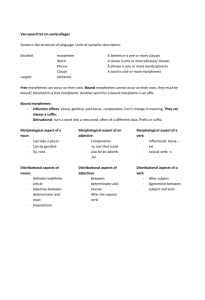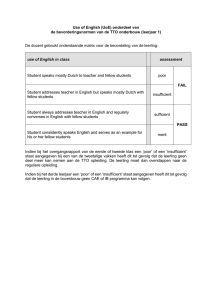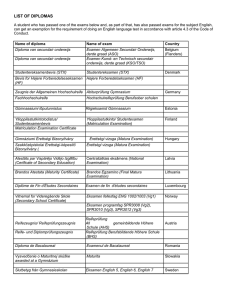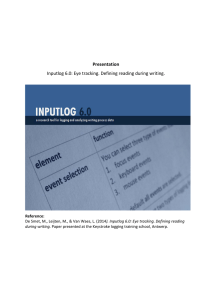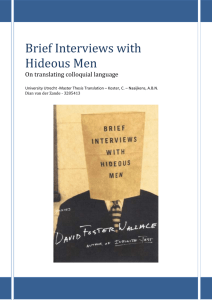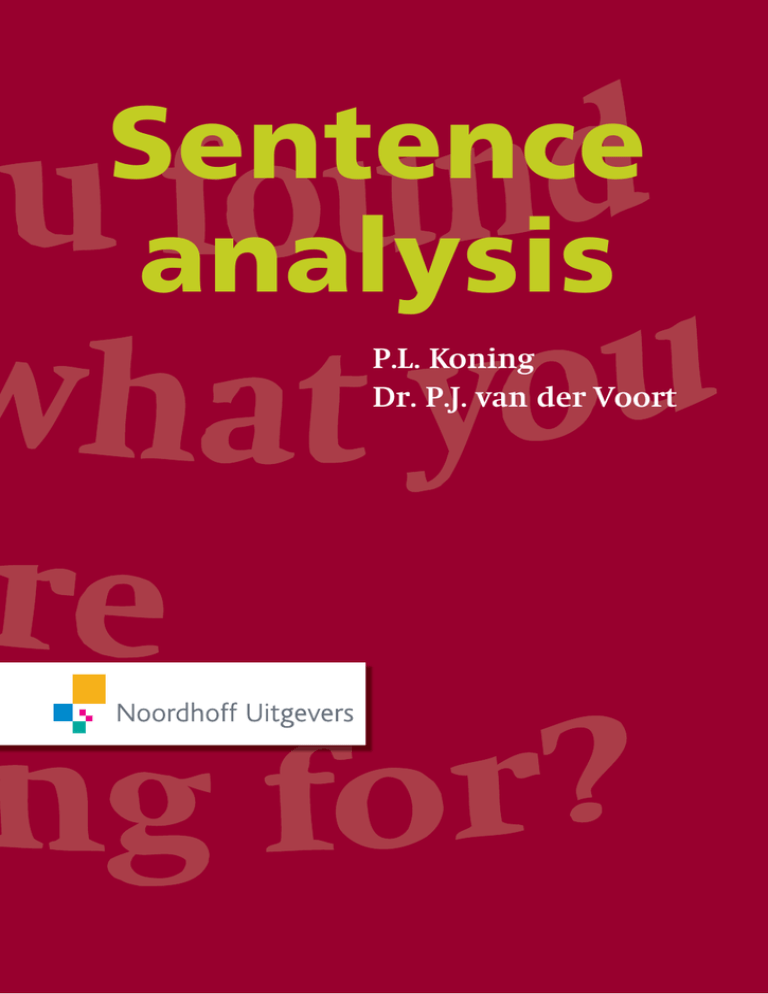
Sentence
analysis
P.L. Koning
Dr. P.J. van der Voort
Sentence analysis
P.L. Koning
Dr. P. J. van der Voort
Sentences analysis
Noordhoff Uitgevers Groningen
Ontwerp omslag: Noordhoff Uitgevers bv
Omslagillustratie: Noordhoff Uitgevers bv
Eventuele op- en aanmerkingen over deze of andere uitgaven kunt u
richten aan: Noordhoff Uitgevers bv, Afdeling Hoger Onderwijs,
Antwoord-nummer 13, 9700 VB Groningen, e-mail: info@noordhoff.nl
3 4 5 6 7 / 13 12 11 10 09
© 1997 Wolters-Noordhoff bv Groningen/Houten, The Netherlands.
Behoudens de in of krachtens de Auteurswet van 1912 gestelde uitzonderingen mag niets uit deze uitgave worden verveelvoudigd, opgeslagen in
een geautomatiseerd gegevensbestand of openbaar gemaakt, in enige
vorm of op enige wijze, hetzij elektronisch, mechanisch, door fotokopieën, opnamen of enige andere manier, zonder voorafgaande
schriftelijke toestemming van de uitgever. Voor zover het maken van
reprografische verveelvoudigingen uit deze uitgave is toegestaan op grond
van artikel 16h Auteurswet 1912 dient men de daarvoor verschuldigde
vergoedingen te voldoen aan Stichting Reprorecht (postbus 3060,
2130 KB Hoofddorp, www.cedar.nl/reprorecht). Voor het overnemen van
gedeelte(n) uit deze uitgave in bloemlezingen, readers en andere
compilatiewerken (artikel 16 Auteurswet 1912) kan men zich wenden tot
Stichting PRO (Stichting Publicatie- en Reproductierechten Organisatie,
postbus 3060, 2130 KB Hoofddorp, www.cedar.nl/pro).
All rights reserved. No part of this publication may be reproduced, stored in a
retrieval system, or transmitted, in any form or by any means, electronic,
mechanical, photocopying, recording, or otherwise, without the prior written
permission of the publisher.
ISBN (ebook) 978-90-01-85157- 6
ISBN 978-90-01-48211-4
NUR 113
Voorwoord
Sentence analysis is bestemd voor studenten Engels aan
lerarenopleidingen, universiteiten en andere opleidingen
waar zinsontleding een onderdeel vormt van het onderwijs in
de Engelse grammatica.
Onze doelstelling is de zinsontleding zo eenvoudig mogelijk
te behandelen, rekening houdend met de beginsituatie van
studenten die geen of nauwelijks kennis hebben van
Nederlandse zinsontleding.
We hebben hierbij getracht om eenvoud en linguïstische
volledigheid te combineren, hetgeen een moeilijke, zo niet
praktisch onmogelijke, opgave is. De stapsgewijze opbouw en
de geïntegreerde oefeningen dragen bij tot de
‘studeerbaarheid’ en bieden tevens goede mogelijkheden
voor het autonoom studeren.
De gehanteerde terminologie is gebaseerd op een consensus
die ontleend is aan de volgende werken:
F. Aarts en J. Aarts, English syntactic structures, Oxford,
Pergamon Press, 1982.
F.G.A.M. Aarts en H.Chr. Wekker, A contrastive grammar of
English and Dutch, Martinus Nijhoff, Leiden, 1987.
L.G. Alexander, Longman English gramma Longman,
London, 1988.
P. Christophersen en A.O. Sandved, An advanced English
Grammar, London, 1969.
R.A. Close, A reference grammar for students of English,
Longman, London, 1975.
Collins Cobuild English language Dictionary, Collins, London,
1987.
X. Dekeyser, Grammaticaal compendium, in: Van Dale groot
woordenboek Engels – Nederlands, Van Dale, Utrecht –
Antwerpen, 1984.
5
J.A. van Ek en N.J. Robat, The students grammar of English,
Blackwell, Oxford, 1984.
G. Geerts e.a., Algemene Nederlandse spraakkunst, WoltersNoordhoff, Groningen, 1984.
S. Greenbaum en J. Whitcut, Longman guide to English usage,
Longman, London, 1988.
P. Koning en P.J. van der Voort, An English grammar for
student teachers, Wolters-Noordhoff, Groningen, 1984.
G. Leech en J. Svartvik, A communicative grammar of English,
Longman, London, 1975.
Longman dictionary of English language and culture, Longman,
London, 1992.
R. Quirk, S. Greenbaum, G. Leech, J. Svartvik, A grammar of
contemporary English, Longman, London, 1972.
J. Sinclair e.a., Collins Cobuild English grammar, Collins,
London, 1990.
P.L. Koning
Dr. P.J. van der Voort
6
Tijdens het schrijven van dit boek is mijn mede-auteur Piet
Koning overleden. Als nagedachtenis aan onze jarenlange
samenwerking draag ik dit werk aan hem op.
Piet van der Voort
Waalwijk 1997
7
Contents
1
The sentence 11
1.1
1.2
Definition 11
Types of sentence 11
2
2.1
2.2
3
3.1
3.2
3.3
3.4
3.5
3.6
4
4.1
4.2
4.3
4.4
4.5
4.6
4.7
4.8
Words 14
Word classes 14
Parsing 17
Phrases 20
Noun phrase 21
Verb phrase 25
Adjective phrase 31
Adverb phrase 33
Preposition phrase 35
Phrases within phrases 37
Sentence elements 41
Subject 41
Predicate 43
Predicator 43
Subject complement 47
Direct object 52
Object complement 54
Indirect object 56
Adverbial 59
9
5
5.1
5.2
5.3
6
6.1
6.2
6.3
6.4
6.5
7
7.1
7.2
7.3
7.4
7.5
7.6
8
8.1
8.2
8.3
8.4
9
9.1
9.2
The simple sentence 62
Definition 62
SPOCA model for analysis 63
Examples of analysing a simple sentence 64
The complex sentence 74
Definition 74
Subordinate clauses and superordinate clauses 76
Subordinating conjunctions 76
Coordinate clauses and coordinating conjunctions 78
Finite, non-finite and verbless subclauses 80
Subclauses functioning as sentence elements 84
Subject clause 84
Subject complement clause 85
Direct object clause 86
Object complement clause 87
Indirect object clause 89
Adverbial clause 89
Subclauses functioning as phrase elements 93
Subclauses in a noun phrase 93
Subclauses in an adjective phrase 100
Subclauses in an adverb phrase 101
Subclauses in a preposition phrase 101
Analysis of a complex sentence 103
Examples of analysis 104
Additional sentences for analysis 121
Index 126
10
1
The sentence
Definition
1.1
A sentence is a word or usually a group of words that, when
written down, begins with a capital letter and ends with a full
stop, a question mark or an exclamation mark. In speaking,
sentences are, normally, preceded and followed by a pause.
1
2
3
4
Yes.
It is a nice day.
All right!
Do you speak English?
Types of sentence
1.2
Sentences can be classified according to form and according
to meaning. The following types of sentence can be
distinguished:
a
according to form
–
simple sentences (enkelvoudige zinnen)
1 Janet is a nice girl.
The simple sentence will be discussed in chapter 5.
–
complex sentences (samengestelde zinnen)
2 Janet is a nice girl, but her sister is even nicer.
3 If I have time, I will certainly come to your party.
11
4 The doctor advised her to stop smoking.
5 Walking in the park, I met an old colleague of mine.
The complex sentence will be discussed in chapter 6.
b
according to meaning
Each of the following types is either affirmative (bevestigend)
or negative (ontkennend):
–
declarative sentences (mededelende zinnen)
6 She speaks English fluently.
7 I do not speak Russian.
Declarative sentences are also called statements.
–
interrogative sentences (vragende zinnen)
8 Do you speak English?
9 Does not he speak German?
Interrogative sentences are also called questions.
–
imperative sentences (bevelende zinnen)
10 Shut the door! (command = bevel)
11 Do not walk on the grass! (prohibition = verbod)
Affirmative imperative sentences are also called commands;
negative imperative sentences are also called prohibitions.
Imperative sentences do not always express a command or a
prohibition, but may also express other ideas, such as a
request, an invitation or a wish:
12 Please, don’t walk so fast!
13 Come and see me tomorrow.
14 Have a good journey!
Imperative sentences with ‘do’ express an urgent request rather
than a real command:
15 Do stay a bit longer!
12
Hoofdstuk 1
16 Do be silent, please!
–
exclamatory sentences (uitroepende zinnen):
Exclamatory sentences often begin with ‘how’ or ‘what’:
17 How well she plays the piano!
18 What a charming woman she is!
19 Isn’t that nice!
Exclamatory sentences are also called exclamations.
Exercise 1
Exercise
A
What is a sentence?
B
Give two examples of each of the following types of sentence:
1
2
3
4
5
6
7
8
13
affirmative declarative sentence
negative declarative sentence
affirmative interrogative sentence
negative interrogative sentence
affirmative imperative sentence
negative imperative sentence
affirmative exclamatory sentence
negative exclamatory sentence
Hoofdstuk 1


